Day 1 of a three day long weekend of Early Winter Tours today. It still had a distinctly autumnal feel this morning, misty and grey first thing. The cloud gradually lifted a bit and even though it remained cloudy, it was dry and mild.
As we made our way east along the coast road, we could see a couple of large skeins of Pink-footed Geese flying in from the coast. They landed in a field by the road and through the hedge we could see thousands of them already packed in there. Unfortunately there was nowhere to pull in and we had someone else right behind us, so we couldn’t stop.
Our first destination for the morning was Blakeney. As we got out of the car by the harbour, it was rather misty further out across the saltmarsh. A lone Curlew was busy feeding down in the harbour channel. We stopped by the wildfowl collection briefly – amongst all the captive exotics there were lots of opportunists come to help themselves to all the seed put out, mostly Mallards and Black-headed Gulls.
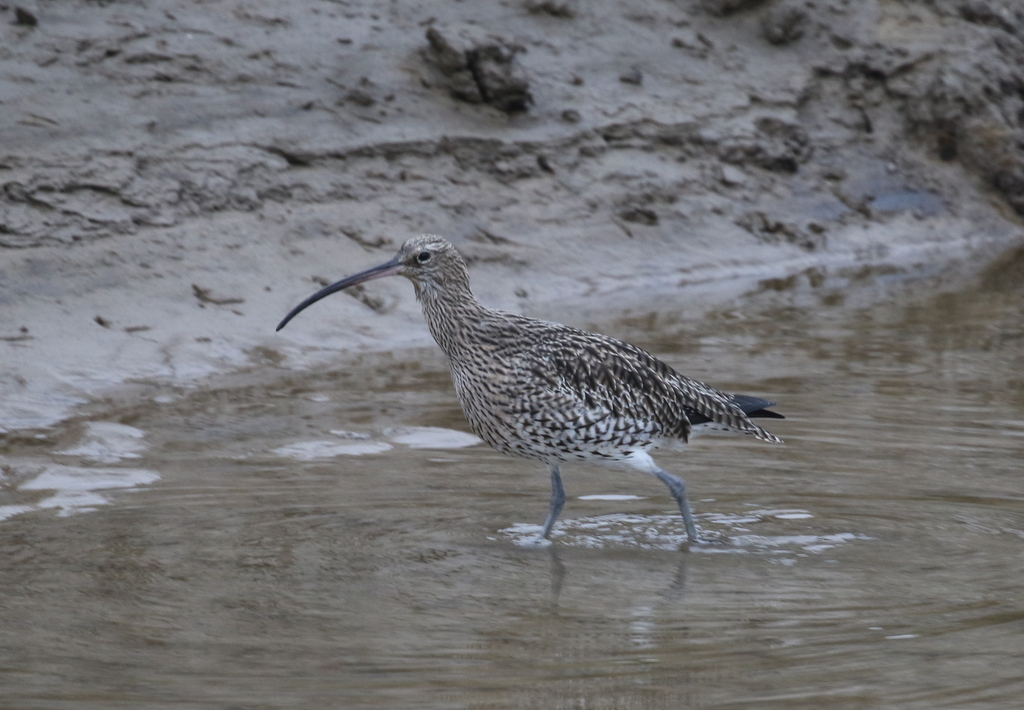
A gaggle of Brent Geese was feeding out on the saltmarsh in the middle of the harbour, so we got the scope on them for a closer look. There was a gathering of gulls next to them, again mainly Black-headed Gulls with one or two Common Gulls in amongst them. A couple of Lesser Black-backed Gulls were perched on the top of the masts of the yachts pulled up at the far end of the car park.
A slightly paler backed large gull was swimming down in the harbour channel. It was not pale enough for a Herring Gull, and too dark for a Lesser Black-backed Gull, with legs neither pink nor yellow, but a rather insipid fleshy colour. It is a regular here, and has been coming back for years, having found rich pickings on the seed in the wildfowl collection. It is a hybrid, probably Lesser Black-backed x Herring Gull.
Looking out across the grazing marshes, we could see three Marsh Harriers circling in the mist, slow to get going this morning. One perched in the top of a bush so we could look at it in the scope. A Common Buzzard flew over, heading for the trees over by the village. Then out over the saltmarsh, we spotted a Merlin hunting, flying across low and fast. We got several flashes of it as it darted back and forth and then it eventually landed, perched on a dead branch out in the middle.
The pools below the bank held a few Teal and one or two Redshank. A Little Grebe was busy diving on the largest of them. A Water Rail squealed from deep in the reeds and a couple of Reed Buntings flew up and across to the saltmarsh. A flock of Linnets was feeding out on the edge of the harbour, and whirled round from time to time.
A pipit flew in over the bank calling, and dropped down onto a small puddle in the cut grass on the edge of the Freshes. It was a Rock Pipit – come in from the salty side for a bathe. As it fed round the edge for a couple of minutes beforehand, we could see it was wearing a yellow colour ring and through the scope we could read the black letters. It is probably from Norway – the Rock Pipits which spend the winter out on the saltmarsh here are of the Scandinavian race, littoralis.
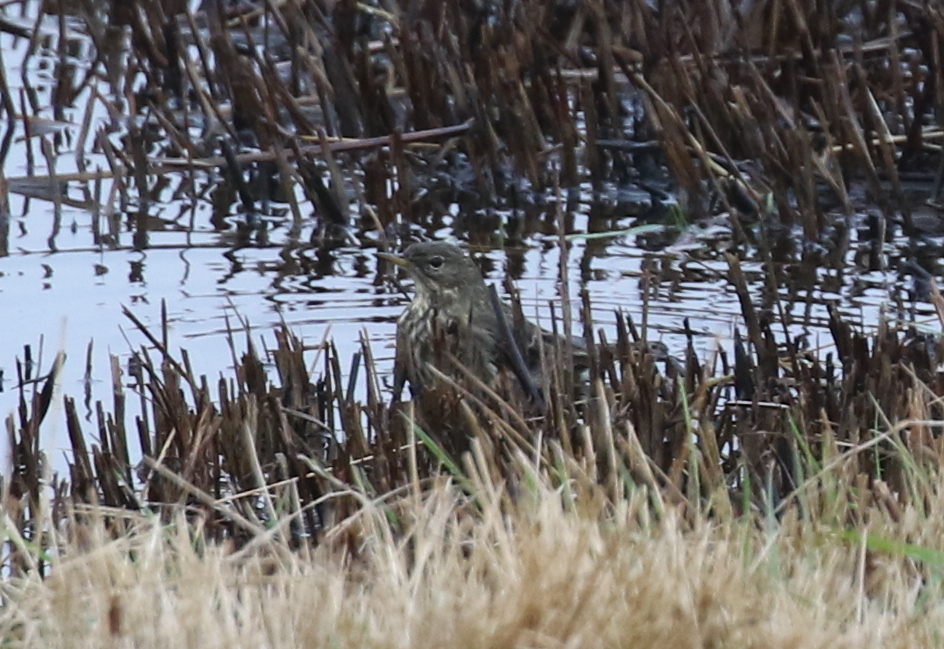
Looking out into the harbour from the corner of the seawall, we could see lots of waders on the more open mud. Hundreds of small Dunlin were scurrying around busily, with a scattering of the larger Grey Plover standing or walking slowly around in amongst them. Two slightly larger and dumpier grey birds in with the Dunlin were two Knot. There were more Redshank and Curlew too. When something flushed lots of waders from further out in the harbour, a flock of Black-tailed Godwits circled round and we spotted three Common Snipe which came calling out of the mist.
This is a good site for Twite in the winter and there has been a group here for the last few days. As we stood scanning the harbour, they flew in and landed down by the path in the wet grass briefly. Unfortunately, just at that moment, two people decided to walk down the path and flushed them.
Thankfully the Twite didn’t fly far and landed again in the low vegetation a little further along. We walked over and got great views of them in the scope, sixteen of them in total (although they are very well camouflaged even in the low vegetation and not easy to count!). We could see their yellow bills and orangey breasts. Three Skylarks were picking around in the low vegetation too.
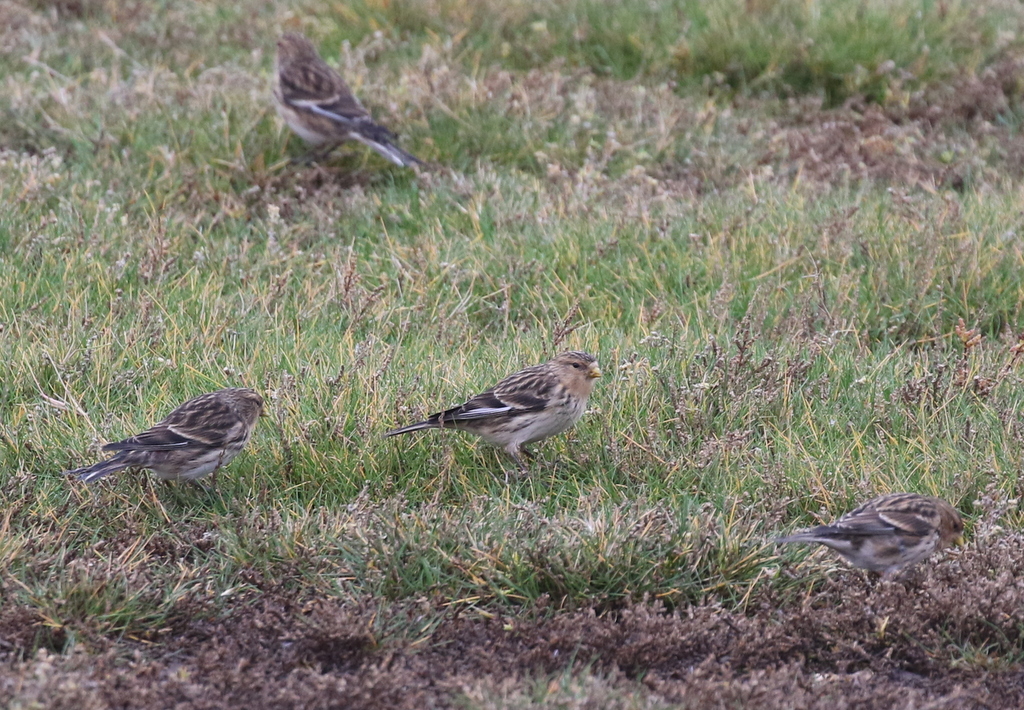
On the walk back to the car, we found a pair of Stonechats feeding in the reeds just below the seawall. We stopped to watch them, fluttering up from the tops, flycatching, before landing back and flicking their tails.
Continuing on east along the coast, our next stop was at Sheringham. We wanted to try to see the King Eider which has been lingering offshore here for a couple of weeks now. It has been favouring the water off the west end of the prom, so we started our search there. There were several Great Black-backed Gulls and Herring Gulls on the groynes below the cliffs and a 1st winter Caspian Gull flew past, heading west towards a couple of crab boats which were hauling up their pots away to the west, surrounded by gulls.
Looking out to sea, we could see lots of Starlings coming in over the water, in small groups or larger flocks of 50 or so, birds arriving from the continent for the winter. They seemed to be streaming in constantly. Several groups of Starlings came in right towards us and over the cliffs where we were standing. There were a few thrushes in with them, Redwings and Fieldfares. One or two Blackbirds came in low over the sea too.
We picked up a Woodcock coming in next. It seemed to head straight into the face of the cliffs, but a couple of seconds later it circled over the top and came along the path straight towards us. At the last minute it saw us, just before it crashed into us, panicked and went to land on the path just a couple of metres away, then changed its mind and flew up over the bank and off across the golf course. There was a great variety of migrants arriving this afternoon – this Woodcock had possibly come in all the way from Russia for the winter.
There was no sign of the King Eider on the sea off the lifeboat station, so we walked a little further west along the cliffs until we had a better view beyond. We stopped to scan and could see a few Gannets circling out over the water. A small group of Red-throated Divers flew past. There were a few ducks moving offshore too – a flock of Wigeon, then a line of Common Scoter with several Teal following behind – more migrants arriving for the winter.
Finally we spotted the King Eider, but it was a long way back to the east of where we were now. We had a quick look through the scope, but it was rather distant. So we walked back towards the prom to try to get a closer look. Unfortunately, by the time we got there, it had disappeared again. A crab boat had motored out to where it had just been.
There are normally one or two Purple Sandpipers which spend the winter here, so we decided to walk down along the prom to see if we could fine one, while keeping our eyes peeled for the King Eider. Half way along, we met a couple of other birders who had found the King Eider again, but it was now a lot further out. Apparently, it had moved offshore in response to the crab boat. It was also steadily drifting east. We had another look at it, but figured we might be able to get a better view from the east end.
We scanned the rocky sea defences as we made our way further. There were lots of Turnstones along the prom, perched on the wall, or feeding on chips thrown down onto the concrete for them. When we got to ‘the tank’, we looked over the railing and could see a Purple Sandpiper feeding with one of the Turnstones on the seaweed covered rocks below us.

Thankfully we had already enjoyed good views of the Purple Sandpiper, before something spooked all the birds along the prom – gulls, feral pigeons, waders, the lot. We couldn’t see any likely threat here, but the Turnstones flew off and took the Purple Sandpiper with them.
Finally, we got a good view of the King Eider from here. It is an immature male, still moulting out of eclipse plumage, but over the last couple of weeks it has been here it is gradually starting to look a bit brighter. We could see the bright orange frontal lobes at the base of the bill, between its regular dives to look for crabs.
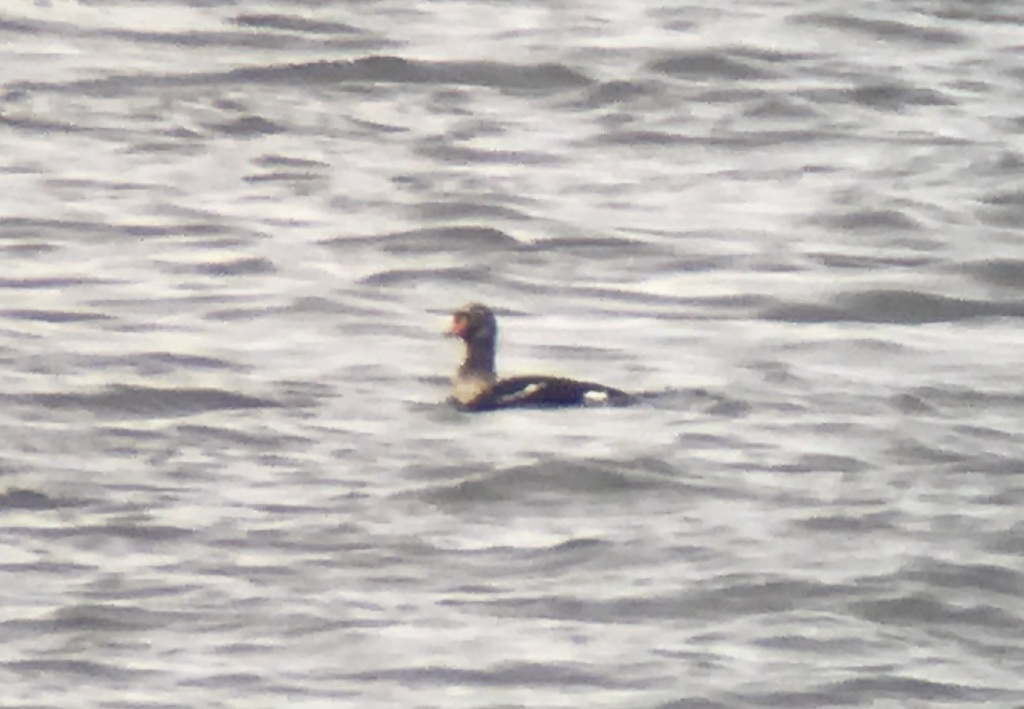
King Eider is a high arctic species, which is very rare this far south. They breed in arctic Russia and winter along the north Scandinavian coast. Presumably, once this bird completes its moult, it will make its way back north. But in the meantime, it seems to be finding plenty to eat here.
Back at the car, we stopped for lunch in one of the shelters on the top of the cliffs, overlooking the sea. Afterwards, we started to make our way back west.
When we got to Salthouse, we turned towards the beach. There were lots of Wigeon on the pools on the edge of the grazing marsh. We parked and walked up over the shingle until we could see the sea. A few Gannets drifted past offshore and one of the first birds we found on the sea was the Great Northern Diver which had been reported here earlier. We had a good look at it through the scope between dives – a big diver with a heavy bill and black half collar.
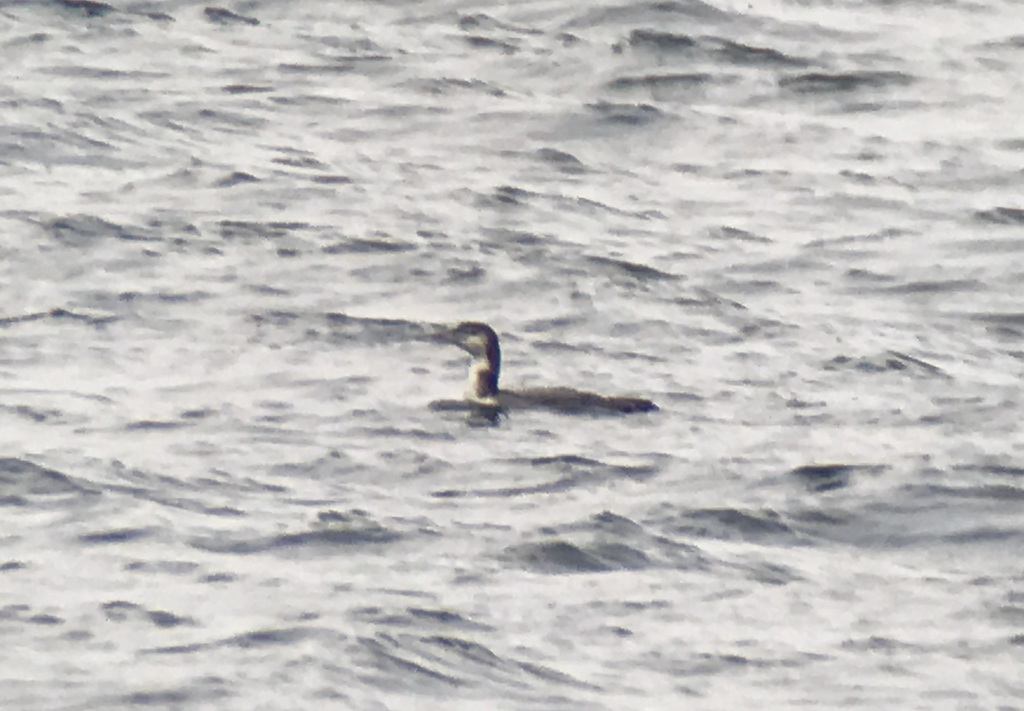
There were several Guillemots and Razorbills further out on the sea today, all busily diving too. A group of at least 18 Pied Wagtails were feeding further up the beach on the top of the shingle, fluttering about looking for insects on the stones.
As we made our way back to the car, we bumped into one of the locals who informed us that the Yellow-browed Warbler was showing well just the other side of Sarbury Hill. We found somewhere to park and walked along the footpath to where it had been. There were a couple of other people there watching it and after a minute or so it flew up into a sycamore in the hedge.
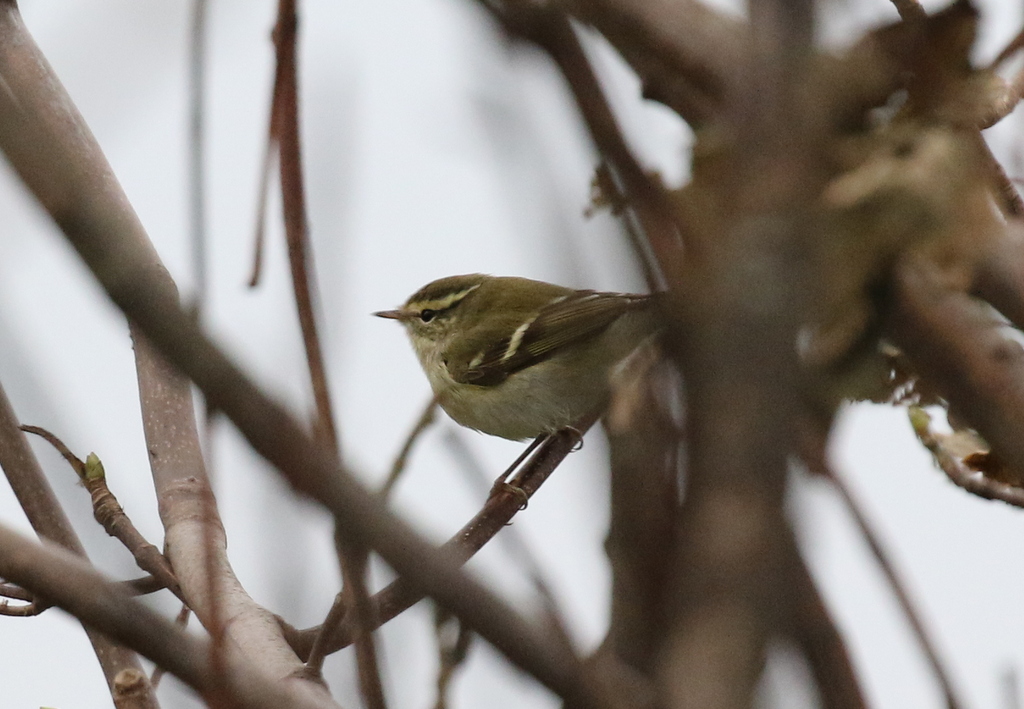
The Yellow-browed Warbler was hard to see at first, flitting around in the back of the tree and occasionally disappearing down into some thicker hawthorns next to it, but eventually everyone got a good look at it. This is rather late for a Yellow-browed Warbler – they are regular now between mid September and the end of October, but few linger this long. Hopefully it will still find enough food to fuel up before continuing on its journey.
We headed round to Cley beach next, in the hope we might catch up with a Short-eared Owl here. Half way along Beach Road, we stopped to talk to a couple of people up on the West Bank looking out over the marshes beyond. They had just seen a Short-eared Owl, but it had gone down into the vegetation out along the start of Blakeney Point.
We continued on to the car park, intending to have a look out to sea from here while keeping one eye out for the owl. As we got out of the car, a large flock of Golden Plover whirled over the Eye Field, breaking up into smaller groups and joining up again, before drifting away. Their yelping calls alerted us to several skeins of Pink-footed Geese flying in from the west. We watched as they whiffled down onto the grazing marshes. Through the scope, we could see a flock of Brent Geese, a couple of Canada Geese and all the Pinkfeet in one view.

Turning our attention to the sea, a quick scan revealed three Velvet Scoters offshore. Through the scope, we could see the two white spots on their dark brown faces and the white in the wing forming a diagonal white stripe on their flanks. A female Common Scoter appeared with them and several Guillemots were offshore too.
With no sign of the Short-eared Owl reappearing, we decided to walk along the shingle to see if we could find the flock of Snow Buntings which had been along here earlier. We had just started walking away when we got a phone message to say the owl was up again and headed our way. We turned back, and had another scan which quickly revealed the Short-eared Owl perched on the top of a post, against the skyline.
One everyone had enjoyed a good look at the Short-eared Owl through the scope, it was off again hunting, flying with distinctive stiff wing beats. It disappeared round behind some gorse bushes and didn’t come out the other side so presumably had landed again. We could see several Marsh Harriers starting to gather over the marshes beyond, before going to roost.
It was getting dark fast now, not helped by the grey and overcast afternoon, but we decided to have a quick look for the Snow Buntings anyway. We got as far as the point where the vegetation is thickest on the top of the shingle, between the pill box and North Scrape, when we head a ‘crest calling and turned to see it fly right past us. It was either a Goldcrest or a Firecrest, though it sounded perhaps more like the latter, presumably fresh in off the sea. It circled round, but unfortunately we lost sight of it in the gloom as it dropped down into the vegetation. We had a quick look where it seemed to go down but there was no sign.
The light was clearly going now, so we decided to call it a day and head back to the car. With more birds arriving this evening, it will be interesting to see what tomorrow brings.
















